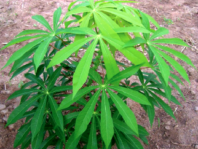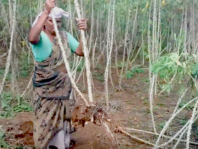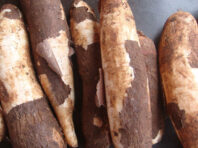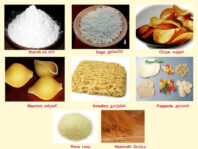Tapioca
Season and Field preparation
Climate and Soil
Any well drained soil preferably red lateritic loam with a pH range of 5.5 -7.0 is best suited for tapioca cultivation. It thrives best in tropical, warm humid climate with well distributed rainfall of over 100 cm per annum. This crop can be cultivated upto an elevation of 1000 m.

Tapioca Plant

Tapioca Plantation

Cassava Harvesting

Tapioca

Sow the seeds during June or January to April
Season and planting
Plant throughout the year under irrigation. Plant during April for rainfed crop. Select healthy mosaic free vigorous plants for taking planting materials. Prepare setts of 15 cm long with 8 – 10 nodes from the middle portion of the stem. Avoid mechanical damage while preparation and handling of setts. The cut end should be uniform. Dip the setts in Carbendazim 1 g in one l of water for 15 minutes before planting. Plant the setts vertically with buds pointing upward on the sides of ridges and furrows. 17,000 setts are needed for planting one ha. For rainfed conditions, treat the setts with a mixture of potassium chloride @ 5 g/lit and micronutrients viz., ZnSO4 and FeSO4 each @ 0.5%for 20 minutes.Dip the setts for 20 minutes in Azospirillum and phosphobacteria each at 30 g/l.
Preparation of field
Plough the field 4 – 5 times to get a fine tilth. The soil depth should be atleast 30 cm and form ridges and furrows at the following spacing.
Planting
Plant the setts vertically with buds pointing upward on the sides of ridges and furrows at following spacings.
Irrigated: 75 x 75 cm (17,777 setts) and 90 x 90 cm (12,345 setts)
Rainfed: 60 x 60 cm (27,777 setts)
Under Kanyakumari conditions: 90 x 90 cm (12,345 setts)
Irrigation
First irrigation is given at the time of planting. Life irrigation is given on the 3rd day followed by once in 7 – 10 days upto 3rd month and once in 20 – 30 days upto 8th month.
Drip irrigation
Install drip system with main and sub-main and place the inline laterals at the interval of 1.5 m. Place the drippers at the interval of 60 cm for 4 LPH and 50 cm for 3.5 LPH in the lateral system. Form the raised beds at 120 cm width at an interval of 30cm and place the laterals at the centre of each bed.
Sequential cropping
Raise Co 2 vegetable cowpea during March and harvest green pods before planting cassava during June –July. After green pod harvest, incorporate the cowpea haulms into the field by disc ploughing. Through sequential cropping 50% reduction in application of FYM (12.5 t/ha) and P (30 kg/ha) is ensured.
Irrigated crops
Apply 25 t/ha FYM and incorporate at the time of ploughing. Apply 45:90:120 kg NPK/ha as basal and 45:120 kg NK/ha on 90 days after planting during earthing up.
Rainfed crop
FYM at 12.5 t/ha along with 50 kg N, 65 kg P and 125 kg K/ha is applied as basal. 2 kg of Azatobactor is appliedas soil application at 30 – 60 days after planting on receipt of showers (2.0 kg Azatobacter + 20 kg FYM + 20 kg soil per hectare).
Fertigation requirement
90: 90 :240 kg of NPK / ha. Apply once in every three days throughout the cropping period.
Spacing
60 x 90cm in paired row system.
Chlorosis
Micro nutrient deficiency can be controlled by foliar spraying of 1% FeSO4 + 0.5% ZnSO4 at 60 and 90 DAP.
After cultivation
Fill up the gaps within 20 days of planting. Carry out 1st weeding 20 days after planting. Subsequent weedings should be done once in a month upto 5 months depending upon the weed intensity.
Thin to two shoots per plant during 60th day. Grow aggregatum onion, coriander, short duration pulses and short duration vegetables as intercrops from planting date upto 60 days.
